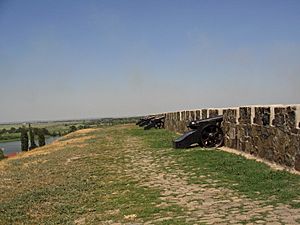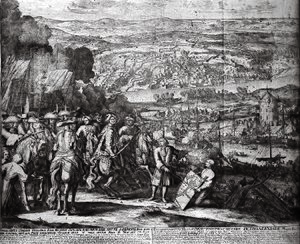Azov facts for kids
Quick facts for kids Azov (English)Азов (Russian) |
|
|---|---|
| - Town - | |
 |
|
|
|
|
| Administrative status | |
| Country | Russia |
| Federal subject | Rostov Oblast |
| Administratively subordinated to | Azov Urban Okrug |
| Municipal status | |
| Urban okrug | Azov Urban Okrug |
| Leader | Sergey Bezdolny |
| Statistics | |
| Population (2010 Census, preliminary) |
82,937 inhabitants |
| - Rank in 2010 | 198th |
| Time zone | MSK (UTC+04:00) |
| Founded | 13th century |
| Town status since | 1708 |
| Postal code(s) | 346780 |
| Dialing code(s) | +7 86342 |
Azov (pronounced "Ah-zoff") is a historic town in Rostov Oblast, Russia. It sits right on the Don River, only about 16 kilometers (10 miles) from the Sea of Azov. The sea actually got its name from this very town! Azov is home to around 81,924 people.
Contents
History of Azov
Ancient Settlements Near the Don River
The area around the Don River's mouth has always been a busy place for trade. Around 300 BCE, ancient Greeks built a colony here called Tanais. It was named after the Greek name for the river.
Later, in the 1st century BCE, a king burned the settlement down. Greek settlers rebuilt it, making it rich again. But in the 3rd century CE, a group called the Goths almost completely destroyed it. Today, you can still see where ancient Tanais was, and archaeologists have been digging there since the mid-1800s.
Over the centuries, different groups lived here. In the 5th century, the Huns were in charge. Then, in the 7th century, Khan Kubrat started a kingdom called Old Great Bolgary. Later, the Khazars took control.
Azov's Name and New Rulers
In the 10th century, the Slavic princedom of Tmutarakan controlled the area. Then, in 1067, the Kipchaks arrived and renamed the place Azaq. This name meant "lowlands," and it's where the modern name Azov comes from.
In the 13th and 14th centuries, the Golden Horde ruled most of the coast. But they let merchants from Venice and Genoa settle in Azov. These merchants built a trading post they called Tana.
Archaeological Discoveries
In 2000, a famous explorer named Thor Heyerdahl became interested in Azov. He wanted to explore his idea that ancient Scandinavians might have traveled from the south. He was looking for the origins of Odin, a god from Norse myths.
A writer from the 1200s, Snorri Sturluson, wrote that Odin came from the Caucasus region, east of the Black Sea. Heyerdahl wanted to see if this was true. So, in 2001, he helped organize an archaeological dig in Azov. He planned another dig, but sadly, he passed away in 2002.
Azov Fortress
In 1471, the Ottoman Empire took control of Azov and built a very strong fort called Azak. This fort stopped the Don Cossacks from using the Black Sea for raids and trade. The Cossacks tried to attack Azov many times.
In 1637, three thousand Don Cossacks and four thousand Zaporozhian Cossacks surrounded Azov. The fort fell to them on June 21. The Cossacks asked the Tsar (the Russian ruler) for help, but he didn't want to risk war with Turkey.
In 1641, a large Ottoman army tried to take the fort back. They had to leave because many soldiers got sick. The Tsar eventually ordered the Cossacks to leave, and the Ottomans took Azov back in 1642.
Peter the Great and Later Wars
The Azov Fortress saw many more battles. In 1696, Peter the Great, who wanted Russia to have access to the Black Sea, managed to capture the fortress. Azov became a town in 1708.
However, after a difficult war in 1711, Peter had to give Azov back to the Turks. The famous writer Voltaire even wrote a funny story about these events in his book Candide.
During the Great Russo-Turkish War (1768-1774), Russian forces took Azov again. It was finally given to Russia in 1774 as part of a peace treaty. For seven years, Azov was the center of its own region. But as the nearby city of Rostov-on-the-Don grew, Azov became less important.
Azov was occupied by German and Austrian forces during World War I (1917–1918). It was also occupied by the Germans during World War II, from July 1942 to February 1943.
Azov's Government
Azov is an important city in the Rostov Oblast region. It acts as the main center for Azovsky District. However, Azov itself is managed separately, like its own special area. This means it has a similar status to a district within the region.
Climate of Azov
Azov has a humid continental climate. This means it has hot summers and cold winters. The winters are quite mild for Russia. The town also gets a fair amount of rain throughout the year.
| Climate data for Azov | |||||||||||||
|---|---|---|---|---|---|---|---|---|---|---|---|---|---|
| Month | Jan | Feb | Mar | Apr | May | Jun | Jul | Aug | Sep | Oct | Nov | Dec | Year |
| Mean daily maximum °C (°F) | −0.9 (30.4) |
0.3 (32.5) |
6.2 (43.2) |
16.3 (61.3) |
22.8 (73.0) |
26.5 (79.7) |
28.7 (83.7) |
27.9 (82.2) |
22.5 (72.5) |
14.6 (58.3) |
7.5 (45.5) |
2.5 (36.5) |
14.6 (58.2) |
| Mean daily minimum °C (°F) | −7.2 (19.0) |
−6.4 (20.5) |
−1.3 (29.7) |
6.4 (43.5) |
12.3 (54.1) |
16.3 (61.3) |
18.1 (64.6) |
16.8 (62.2) |
11.9 (53.4) |
5.8 (42.4) |
1.4 (34.5) |
−2.9 (26.8) |
5.9 (42.7) |
| Average precipitation mm (inches) | 47 (1.9) |
37 (1.5) |
31 (1.2) |
43 (1.7) |
53 (2.1) |
67 (2.6) |
51 (2.0) |
37 (1.5) |
36 (1.4) |
30 (1.2) |
46 (1.8) |
61 (2.4) |
539 (21.3) |
| Average precipitation days | 9 | 7 | 6 | 7 | 7 | 7 | 6 | 5 | 5 | 5 | 8 | 10 | 82 |
| Source: World Meteorological Organisation (UN) | |||||||||||||
Things to See in Azov
Azov has many interesting monuments and museums to visit.
Powder Cellar Museum
The Powder Cellar Museum was built in 1799. It is the only remaining fortress building from Catherine the Great's time in southern Russia. Other fortresses she built were destroyed. This makes Azov's cellar very special. It shows how military buildings were designed in the 1700s.
The cellar was first used to store gunpowder. Later, it was used to store ice. From 1961 to 1965, it was fixed up and became part of the Azov Museum of History, Archaeology and Palaeontology.
Diorama: The Taking of Azov
In 1967, to celebrate Azov's 900th birthday, a special display opened. It's a diorama called "The taking of Azov by the troops of Peter the Great in 1696." A Russian artist named Arseniy Chernyshov created this amazing scene.
Azov Fortress
The Azov Fortress is a group of old fortified buildings. It looks over the Don River and the Port of Azov. You can see its ramparts (defensive walls), watchtowers, and gates.
Monuments
- Monument to Peter I is a bronze statue of Peter the Great. It stands in the center of Azov. Sculptors Oleg Komov and Andrey Kovalchuk designed it. It was unveiled on July 19, 1996, to celebrate 300 years of the Russian Navy.
- Monument to Aleksei Shein honors Aleksei Semenovich Shein. He was a Russian general and statesman in the late 1600s. This monument opened on June 12, 2009.
- Monument to the sailors of the Azov Flotilla remembers the brave sailors. They fought heroically in the Don River area during World War II. This monument is an important local cultural site.
Azov Museum of History, Archaeology and Palaeontology
The Azov Museum of History, Archaeology and Palaeontology is one of the largest museums in southern Russia. It has a huge collection of ancient animal fossils. The museum was started on May 17, 1917, by Michail Aronovich Makarovskiy.
Sister Cities
Azov is connected with other cities around the world as "sister cities." This helps build friendships and understanding between different places.
 Aglandjia, Cyprus (1990)
Aglandjia, Cyprus (1990) Chillicothe, United States (1991)
Chillicothe, United States (1991) Feodosia, Ukraine
Feodosia, Ukraine Pylos-Nestor, Greece (2017)
Pylos-Nestor, Greece (2017) Sečanj, Serbia (2018)
Sečanj, Serbia (2018) Courbevoie, France (2018)
Courbevoie, France (2018) Bijeljina, Bosnia and Herzegovina (2018)
Bijeljina, Bosnia and Herzegovina (2018)
Images for kids
-
Azov. Monument to Peter I. 1996
See also
 In Spanish: Azov para niños
In Spanish: Azov para niños






